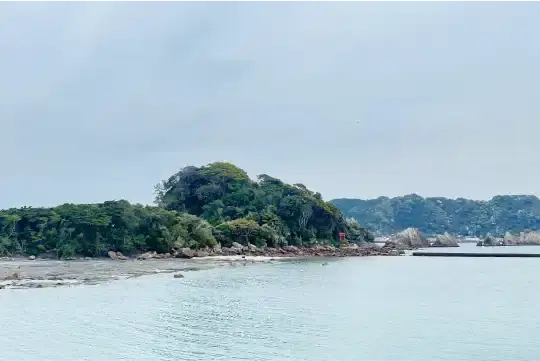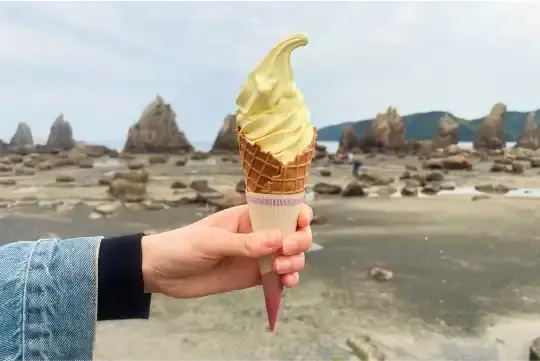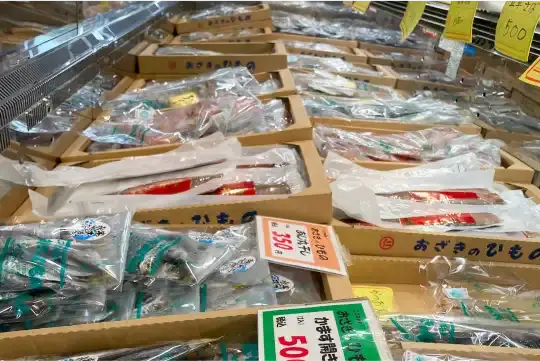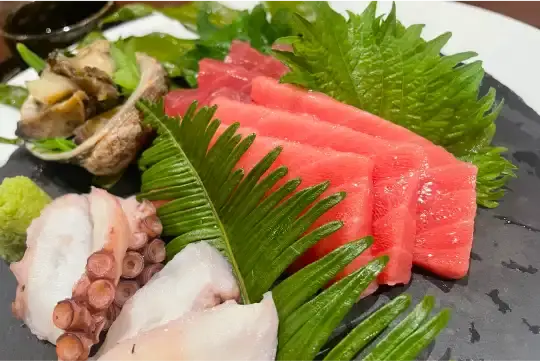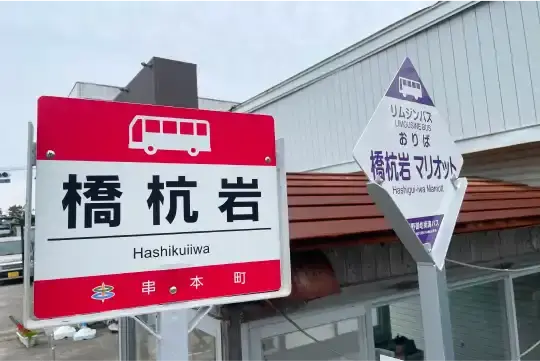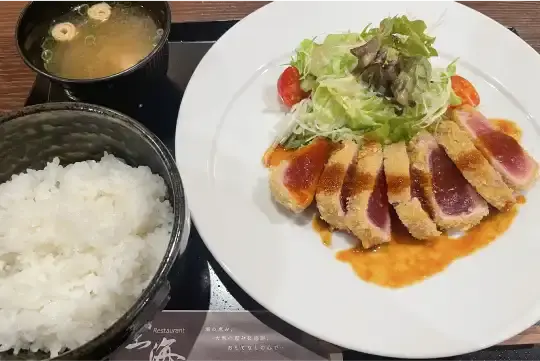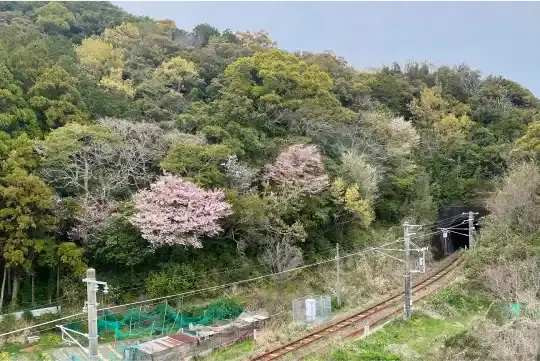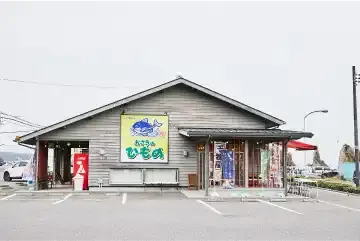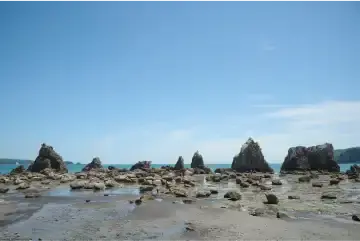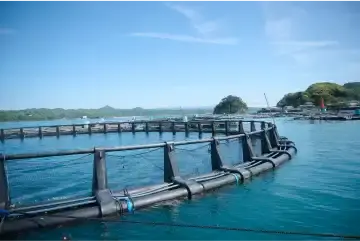A trip to Kushimoto, Wakayama – to the sea full of wonder and discoveries.
My 5th-grade daughter appeared to have learned about the fishing industry in school. She came to us and asked with glee, "Did you know that there is such a thing as tuna aquaculture?" My husband replied, as if a light bulb went on in his head, "Shall we go see a tuna farm?" My daughter, who loves tuna, quickly agreed and shouted, "Yeah!" And so, with that, our schedule for that weekend was set.

It was about a three-hour drive from Osaka. Since the aquaculture tour would start the next day at 9:00 am and we wanted to take it easy on our first day, we decided to first visit the Nanki Kushimoto Tourism Association, which could advise us on our sightseeing. "In Kushimoto, you'll enjoy the many different faces of the sea. For example, there are coral colonies on the west side of the sea that will entertain you with the same sea view as Okinawa when you go snorkeling," said Ui, the director, when we told him that it was our first time in Kushimoto. "No wonder the water is so beautiful," we said excitedly.
He recommended Ozaki no Himono when we asked him for a good place to have lunch. It is a himono (dried fish) shop right by the sea, and in the shop, they grill the himono and serve it in set meals. We thanked him for his help and drove right on.
He recommended Ozaki no Himono when we asked him for a good place to have lunch. It is a himono (dried fish) shop right by the sea, and in the shop, they grill the himono and serve it in set meals. We thanked him for his help and drove right on.
Indulging in exquisite himonos, produced by a specialist.

While Ozaki no Himono specializes in himono, as its name suggests, it also serves a variety of other delicious seafood dishes besides himono, such as maguro-don and shirasu-don (whitebait over rice).
When I shared some of my saba-mirin with my daughter, she said, "Wow! I didn't know himono is this good." Ozaki, the president, happened to be there, so we asked if he could share the secret of making good himono. "Since we opened in 1949, we've been sourcing fish carefully selected by our experts, paying particular attention to color, luster and freshness. We buy fresh fish caught early in the morning in the fishing grounds in front of us and bring them to our processing plant, where we process them one by one," he kindly told us.
When I shared some of my saba-mirin with my daughter, she said, "Wow! I didn't know himono is this good." Ozaki, the president, happened to be there, so we asked if he could share the secret of making good himono. "Since we opened in 1949, we've been sourcing fish carefully selected by our experts, paying particular attention to color, luster and freshness. We buy fresh fish caught early in the morning in the fishing grounds in front of us and bring them to our processing plant, where we process them one by one," he kindly told us.

Ozaki said, "Many of our customers, just like you, would decide to buy himono and take it home after trying a meal saying, 'It’s so good!' Saba mirin has few small bones, so even your daughter will find it easy to eat, right? We also pride ourselves in our unique soy marinade sauce." We enjoyed chatting for a while.
After stuffing ourselves to the gills, we bought some mehari-zushi for dinner at the Michi-no-Eki (roadside station) on the way to the hotel and checked in early to be well prepared for the next day.
As we walked into our room, we could see that Hashigui-iwa Rocks were right in front of us! We also enjoyed the view of Hashigui-iwa Rocks at sunset from the nearby open-air hot spring that we visited later that day, and my daughter and I were again amazed by the view. We were mesmerized by the scenery of the Kushimoto sea, which made us even more excited for the following day's aquaculture experience.
As we walked into our room, we could see that Hashigui-iwa Rocks were right in front of us! We also enjoyed the view of Hashigui-iwa Rocks at sunset from the nearby open-air hot spring that we visited later that day, and my daughter and I were again amazed by the view. We were mesmerized by the scenery of the Kushimoto sea, which made us even more excited for the following day's aquaculture experience.

Heading out on a boat for an aquaculture experience!

Finally, the day of the aquaculture experience was at hand. The instructor, Yamazaki, welcomed us at the meeting point at the port.
The first session we were given was a lecture on tuna aquaculture.
The first session we were given was a lecture on tuna aquaculture.

At the presentation, Yamazaki said, "We started to venture into the challenging world of tuna farming here in Kushimoto some 50 years ago, and at that time, it was said that it would be easier to go to the moon than to farm tuna" and "Today we all know that tuna swim all the time, but this fact was discovered only after we started farming them and we observed them in aquaculture ponds day after day. " My daughter seemed fascinated by the presentation.
After about 10 minutes of talking, Yamazaki said, "Shall we go on the boat now?"
It was finally time, we thought as we three looked at each other.
After about 10 minutes of talking, Yamazaki said, "Shall we go on the boat now?"
It was finally time, we thought as we three looked at each other.
It was such a powerful sight to see tuna biting vigorously into their food.

We saw so many tuna when we looked into the pond! My daughter asked how many there were. "There are about 250, I think. To make it comfortable for them to swim, we made the ponds about 15 meters deep," Yamazaki said.

"Today, we use a machine to throw the feed into the ponds, but what we're offering you here is the classic method," he explained, handing us a box full of sardines. My daughter was a little nervous when she saw it. We told her we'd go first. My husband and I would each have a go.
I used the net according to the lecture and it was surprisingly easy to scoop up the sardines. Nevertheless, this was my first real cast.
Could I do it right? My heart was pounding, but I was encouraged by my husband and daughter who cheered me on, saying, "You can do it!" So, I pushed myself hard to swing the net.
I used the net according to the lecture and it was surprisingly easy to scoop up the sardines. Nevertheless, this was my first real cast.
Could I do it right? My heart was pounding, but I was encouraged by my husband and daughter who cheered me on, saying, "You can do it!" So, I pushed myself hard to swing the net.

Splash! The tuna danced energetically to the surface as soon as the feed touched the water. The sight of tuna swimming vigorously toward the feed blew us away.
"I can't wait for my turn," my daughter said so excitedly. I don't think she remembered how nervous she was just a few minutes ago.
The three of us were so into throwing that we didn't notice the box of sardines was already empty. We took a boat back to the port to go to Minato Matsuri for the tasting, the place to wrap up this adventure.
"I can't wait for my turn," my daughter said so excitedly. I don't think she remembered how nervous she was just a few minutes ago.
The three of us were so into throwing that we didn't notice the box of sardines was already empty. We took a boat back to the port to go to Minato Matsuri for the tasting, the place to wrap up this adventure.
Thinking of the experience, we tried the farm-raised tuna.

My daughter said, "I'm excited to try sashimi," as she looked out the window at the sea. Then the restaurant staff said, "This is the tuna that finally made it after so many struggles in aquaculture. You must try it!" and served each of us a plate of farmed tuna sashimi.
The tuna was moderately fatty, plump and tender. "I remember them saying that they expected people to enjoy farm-raised tuna the same way they enjoy farm-raised premium beef. Now I know what they meant," said my husband. I, too, have been eating tuna without thinking much about it, but it sounds like it's going to be fun to eat and compare tuna by origin and brand from now on.
"The best tuna I ever had," my daughter's murmur reminded me of Yamazaki's words:
"For your children and the next generation, I want to carry on the culture of good tuna and sashimi."
The tuna was moderately fatty, plump and tender. "I remember them saying that they expected people to enjoy farm-raised tuna the same way they enjoy farm-raised premium beef. Now I know what they meant," said my husband. I, too, have been eating tuna without thinking much about it, but it sounds like it's going to be fun to eat and compare tuna by origin and brand from now on.
"The best tuna I ever had," my daughter's murmur reminded me of Yamazaki's words:
"For your children and the next generation, I want to carry on the culture of good tuna and sashimi."
It was for our daughter that we visited Kushimoto, but I feel that it has also broadened my perspective.
I would like to enjoy the beautiful sea and all it has to offer again with the three of us.
I would like to enjoy the beautiful sea and all it has to offer again with the three of us.














